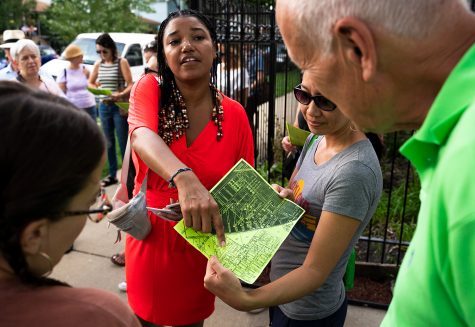Avondale tours reveal the rich history and untold stories of Chicago segregation
September 19, 2019

Nia Easley leads tours through the Avondale community on the city’s Northwest Side, taking everyone on a trip through history leading back to the 1800s.
When Nia Easley leads tours through the Avondale community on the city’s Northwest Side, she does a lot more than point out the best shops or restaurants. Easley takes everyone on a trip through history leading back to the 1800s.
Passing by dog walkers, cast-iron fences and food trucks blasting lively boléro music in the area just north of Logan Square, she points out a little-known fact: Avondale was one of the early homes for black Americans in Chicago — a characteristic more often associated with neighborhoods like Bronzeville on the South Side.
“Often the most compelling explanations for the present lie in the past,” Easley said. “One might still be surprised to learn that one of the pioneer groups to dwell in Avondale were free black Americans.”
Through her tours, writing and advocacy, Easley is challenging people’s preconceived notions about the history of racial segregation in the city.
Easley, who moved to Avondale when she enrolled as a graduate student at the School of the Art Institute of Chicago, said she became curious about the neighborhood’s early black settlers while researching omissions in travel guides used by black citizens during the mid-1900s.
By studying public records and old maps and gathering information from history experts, Easley compiled existing proof that pioneering black families were among the first to officially reside in the area.
Easley held her first public tour Saturday, Sept. 7 as a part of It’s Just Ok, an artistic project that examines what stories are missing from Chicago’s narrative, as well as attitudes toward segregation and displacement.
The tour, which began at Small Bar, 2956 N. Albany Ave., spanned from Kedzie Avenue to Wellington and Troy avenues and included landmarks and historical figures that were vital pillars of Avondale’s formative years. One of Chicago’s official 77 community areas, Avondale is roughly bounded by Addison Street to the north, West Diversey Avenue to the south, The Chicago River to the east and Pulaski Road to the west.

The tour, which began at Small Bar, 2956 N. Albany Ave., spanned from Kedzie Avenue to Wellington and Troy avenues and included landmarks and historical figures that were vital pillars of Avondale’s formative years.
One of the early settlers, the Rev. John Brown Dawson, who was a minister ordained by the African Methodist Episcopal Church, contributed to the founding of Avondale’s first house of worship, AME Allen Chapel in 1876.
In 1880 there were 71 black residents on Dawson’s 7-acre development, and they accounted for two-thirds of Jefferson township’s black population.
“This was a true community of homeowners who built a church, who intended to stay,” Easley said during the tour.
Easley said she has no research to prove why so many black residents left Avondale, although some theories point toward patterns and restrictions as well as opportunities related to The Great Migration.
Dan Pogorzelski, Avondale native, author of “Avondale and Chicago’s Polish Village” and writer for the blog Forgotten Chicago, said through learning about the loss of historical legacies he has come to appreciate the importance in reviving memories.
“Whether it’s for Forgotten Chicago or anything else, [I am] about trying to promote lost narratives or history that’s in danger of being relegated to the dustbin of history,” Pogorzelski said.
Easley said although many Avondale residents claim “todo està bien/it’s all good” in the neighborhood, broader issues of gentrification and segregation are severely affecting the community.
Currently, Avondale’s population of almost 40,000 is 2.1% black and 57% Latinx, according to the 2013-17 American Community Survey. Easley said the number of young white professionals is steadily increasing in the community.
Dominic A. Pacyga, professor emeritus of history at Columbia, said there are a number of factors contributing to Chicago’s history of segregation and gentrification.
“You have to include economic factors in any discussion of segregation, whether it be by social class or by race,” Pacyga said. “When young people move in, redo a building, [make] investments and things like that, older people sometimes can’t keep up with the property tax increases.”
Easley said she plans to continue researching, collaborating with others and giving tours by request until Oct. 2. In the future,Easley said she plans to publish a book to accompany her project in Avondale.
“For me, to know that this community existed on the Northwest Side, even for maybe 50 years, is just an important key to somehow trying to disrupt the complacency around segregation in Chicago,” Easley said.







